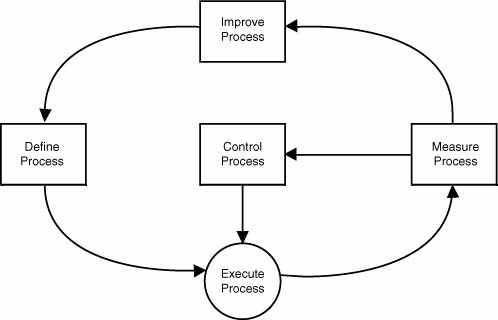Statistical Process Control for Software Development Processes
| Statistical process control is a mainstay in manufacturing but is not yet common in software development. This isn't because software architects and programmers don't have a background in mathematics and statistics, because most do. Rather, the software development process does not naturally produce the kind of high-volume time-series data that is so natural a side effect of the manufacturing assembly line and of all continuous industrial processes. The software development process is any process or subprocess used by a software project or organization. It thus applies to any identifiable activity that may be undertaken to produce a software system or product. This includes planning, estimating, designing, coding, testing, inspecting, reviewing, measuring, and controlling, as well as the subtasks that comprise any of these undertakings.[6] Software process management is all about managing the work processes involved in designing, developing, deploying, maintaining, and supporting both software products and today's increasing array of software-intensive or "digital" systems. The time-honored concept of a controlled process dates back to Walter Shewhart in 1931. It defines a process as being in control when, by using past experience, you can predict within limits how the process may be expected to perform in the future. Controlled processes are stable processes, and process stability lets you predict results. If a controlled process cannot meet changing customer requirements or industry standards, or if it no longer meets business objectives, it must be changed or improved. The four key goals of process management are process definition, process measurement, process control, and process improvement. Deming taught that these goals should be pursued iteratively in his famous Plan, Do, Check, Act (PDCA) approach that has been so successful in manufacturing process improvement. Figure 15.1 is adapted from Florac and Carleton[7] but is familiar to every practitioner of manufacturing process improvement. Our goal here is to apply the rich history of manufacturing process management to software development. The first step in doing so is to discover the measurable product and process characteristics that are important in enterprise business software development. These are presented in Table 15.1, also adapted from Florac and Carleton.[8] This static table suggests a dynamic framework for measuring process behavior; it involves the following:
Such a framework is familiar to software architects and project managers, but they usually pursue it from a qualitative rather than quantitative perspective. This chapter is intended to give the software developer some new, more quantitative tools for managing the software development process. The critical issue in setting up a measurable software process that will be amenable to statistical analysis is identifying measurable characteristics or attributes and selecting the measures. Because the characteristics and their measures differ from project to project, depending on the application and its requirements, we will not attempt to employ all the measures given in Chapter 3 here. Instead, we will define a typical set of measures and use them in an example to give you an overall appreciation of a quantitative framework for software process development. Table 15.2 gives the major criteria for measures to characterize software process performance. Table 15.3 lists a large number of measurable attributes of software development processes as an example only (not all of them are recommended for every project a development group undertakes).
As soon as a set of measurable attributes or characteristics has been selected for a software development project and numerical measures and a data collection system have been set up for them, data will surely begin to flow as work progresses. Figure 15.2, adapted from Florac and Carleton, presents a Venn diagram showing the overlap of problem identification with problem analysis. The methods employed go from qualitative to quantitative, from left to right. The "low-tech" methods on the left are already familiar to you. In the center, the Pareto chart is a commonly used form of the histogram; its use is explained in Chapter 6. The cause-and-effect diagram is another name for Ishikawa's fishbone diagram. The right side of the figure reviews statistical and other quantitative methods; their use is described in the next section. Scatter diagrams display empirically observed relationships between two process attribute measures. Any pattern in the plot may indicate a causal relationship in the data and thus is potentially grist for the statistical millin particular, correlation and regression analysis. Correlation analysis can tell us how closely correlated (corelated) two variables are, and regression analysis can tell us the nature of that relationship. In fact, regression analysis can tell us how much of the variability in one variable can be explained by variation in the other. Multiple regression analysis can tell us, given a large number of measurable influences on an outcome, which are the most significant, and how much of the variability in the result is explained by any chosen subset of them. Usually it's the two or three most significant, which may explain more than 80% of the variability in the result. We won't bore you with statistical formulas. Nobody programs these things anymore. Even high school students do them with a few button presses on a $100 graphing calculator. The serious user will purchase, download, and use the Minitab 14, a comprehensive statistical package. See the Minitab Release 14 URL, http://www.minitab.com/products/minitab/14/default.aspx, for a functional description and ordering information. For the most part, the software process manager can often do quite well using a spreadsheet such as Microsoft Excel. So, what do you need to know about statistics to control a software development process? Let's briefly review the software architect's statistical toolbox and consider an example related to quality. Figure 15.2. The Analytic ToolkitW. A. Florac and A. D. Carleton, Measuring the Software Process, p. 55, Fig. 3.4. © Pearson Education, Inc. Reprinted by permission of Pearson Education, Inc. All rights reserved.  |
EAN: 2147483647
Pages: 394
